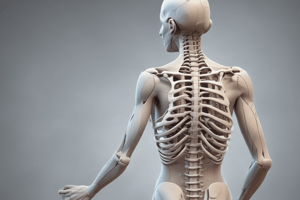Podcast
Questions and Answers
What is a risk factor for curve progression in scoliosis?
What is a risk factor for curve progression in scoliosis?
- Female sex (correct)
- Regular exercise
- Male sex
- Older age
Which of the following is associated with a higher risk of curve progression in scoliosis?
Which of the following is associated with a higher risk of curve progression in scoliosis?
- Younger age
- Older age (correct)
- Male sex
- Good posture
What is NOT a risk factor for curve progression in scoliosis?
What is NOT a risk factor for curve progression in scoliosis?
- Regular exercise
- Younger age
- Female sex
- Male sex (correct)
Which of the following is a risk factor for scoliosis curve progression?
Which of the following is a risk factor for scoliosis curve progression?
What is a risk factor for curve progression in scoliosis patients?
What is a risk factor for curve progression in scoliosis patients?
What demographic characteristic is a risk factor for curve progression in scoliosis?
What demographic characteristic is a risk factor for curve progression in scoliosis?
At what stage of life is curve progression more likely to occur in scoliosis?
At what stage of life is curve progression more likely to occur in scoliosis?
Which of the following is a risk factor for scoliosis curve progression?
Which of the following is a risk factor for scoliosis curve progression?
What is a risk factor for scoliosis curve progression?
What is a risk factor for scoliosis curve progression?
Which of the following is associated with a higher risk of curve progression in scoliosis patients?
Which of the following is associated with a higher risk of curve progression in scoliosis patients?
Flashcards are hidden until you start studying
Study Notes
Risk Factors for Curve Progression in Scoliosis
- Young age at diagnosis, especially before 10 years old, increases the risk of curve progression
- Large curve magnitude ( Cobb angle ≥ 25° ) at diagnosis is associated with a higher risk of curve progression
- Rapid growth spurts during adolescence can lead to rapid curve progression
- Girls are more likely than boys to experience curve progression
- Family history of scoliosis is a risk factor for curve progression
- Certain genetic syndromes, such as Marfan syndrome and Ehlers-Danlos syndrome, increase the risk of curve progression
Studying That Suits You
Use AI to generate personalized quizzes and flashcards to suit your learning preferences.




